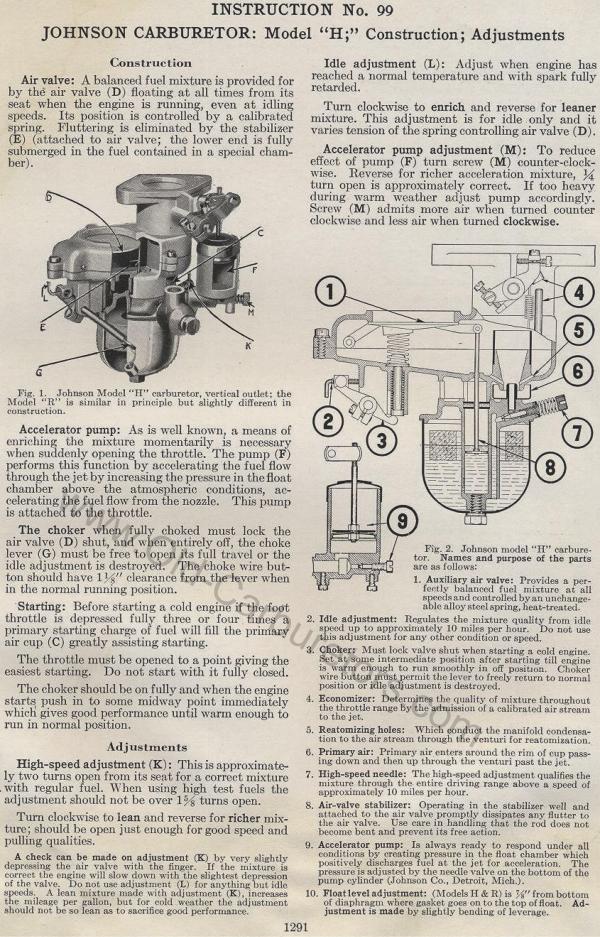JOHNSON CARBURETOR: Model "H;"
Construction; Adjustments
Construction
Air valve: A balanced fuel mixture is provided for by the air valve
(D) floating at all times from its seat when the engine is running,
even at idling speeds. Its position is controlled by a calibrated
spring. Fluttering is eliminated by the stabilizer (E) (attached
to air valve; the lower end is fully submerged in the fuel contained
in a special chamber).
Fig. I. Johnson Model "H" carburetor, vertical outlet;
the Model "R" is similar in principle but slightly different
in construction.
Accelerator pump: As is well known, a means of enriching the mixture
momentarily is necessary when suddenly opening the throttle. The
pump (F) performs this function by accelerating the fuel flow through
the jet by increasing the pressure in the float chamber above the
atmospheric conditions, accelerating the fuel flow from the nozzle.
This pump is attached to the throttle.
The choker when fully choked must lock the air valve (D) shut,
and when entirely off, the choke lever (G) must be free to open
its full travel or the idle adjustment is destroyed. The choke
wire but-ton should have 1%" clearance from the lever when
in the normal running position.
Starting: Before starting a cold engine if the foot throttle is
depressed fully three or four times a primary starting charge of
fuel will fill the primary air cup (C) greatly assisting starting.
The throttle must be opened to a point giving the easiest starting.
Do not start with it fully closed.
The choker should be on fully and when the engine starts push in
to some midway point immediately which gives good performance until
warm enough to run in normal position.
Adjustments
High-speed adjustment (K) : This is approximately two turns open
from its seat for a correct mixture .with regular fuel. W hen
using high test fuels the adjustment should not be over 1% turns
open.
Turn clockwise to lean and reverse for richer mixture; should be
open just enough for good speed and pulling qualities.
A check can be made on adjustment (K) by very slightly depressing
the air valve with the finger. If the mixture is correct the engine
will slow down with the slightest depression of the valve. Do not
use adjustment (L) for anything but idle speeds. A lean mixture
made with adjustment (K), increases the mileage per gallon, but
for cold weather the adjustment should not be so lean as to sacrifice
good performance.
Idle adjustment (L): Adjust when engine has reached a normal temperature
and with spark fully retarded.
Turn clockwise to enrich and reverse for leaner mixture. This adjustment
is for idle only and it varies tension of the spring controlling
air valve (D).
Accelerator pump adjustment (M): To reduce effect of pump (F) turn
screw (M) counter-clockwise. Reverse for richer acceleration mixture,
% turn open is approximately correct. If too heavy during warm
weather adjust pump accordingly. Screw (M) admits more air when
turned counter clockwise and less air when turned clockwise.
Fig. 2. Johnson model "H" carburetor. Names and purpose
of the parts are as follows:
1. Auxiliary air valve: Provides a perfectly balanced fuel mixture
at all speeds and controlled by an unchangeable alloy steel spring,
heat-treated.
2. Idle adjustment: Regulates the mixture quality from idle speed
up to approximately 10 miles per hour. Do not use this adjustment
for any other condition or speed.
3. Choker: Must lock valve shut when starting a cold engine. Set
at some intermediate position after starting till engine is warm
enough to run smoothly in off position. Choker wire button must
permit the lever to freely return to normal position or idle adjustment
is destroyed.
4. Economizer: Determines the quality of mixture throughout the
throttle range by the admission of a calibrated air stream to the
jct.
5. Reatomizing holes: Which conduct the manifold condensation to
the air stream through the venturi for reatomization.
6. Primary air: Primary air enters around the rim of cup passing
down and then up through the venturi past the jet.
7. High-speed needle: The high-speed adjustment qualifies the mixture
through the entire driving range above a speed of approximately
10 miles per hour.
8. Air-valve stabilizer: Operating in the stabilizer well and attached
to the air valve promptly dissipates any flutter to the air valve.
Use care in handling that the rod does not become bent and prevent
its free action.
9. Accelerator pump: Is always ready to respond under all conditions
by creating pressure in the float chamber which positively discharges
fuel at the jet for acceleration. The pressure is adjusted by the
needle valve on the bottom of the pump cylinder (Johnson Co., Detroit,
Mich.).
10. Float level adjustment: (Models H & R) is %" from
bottom of diaphragm where gasket goes on to the top of float. Adjustment
is made by slightly bending of leverage.
Previous page 1927
Supplement Home Next page 
|